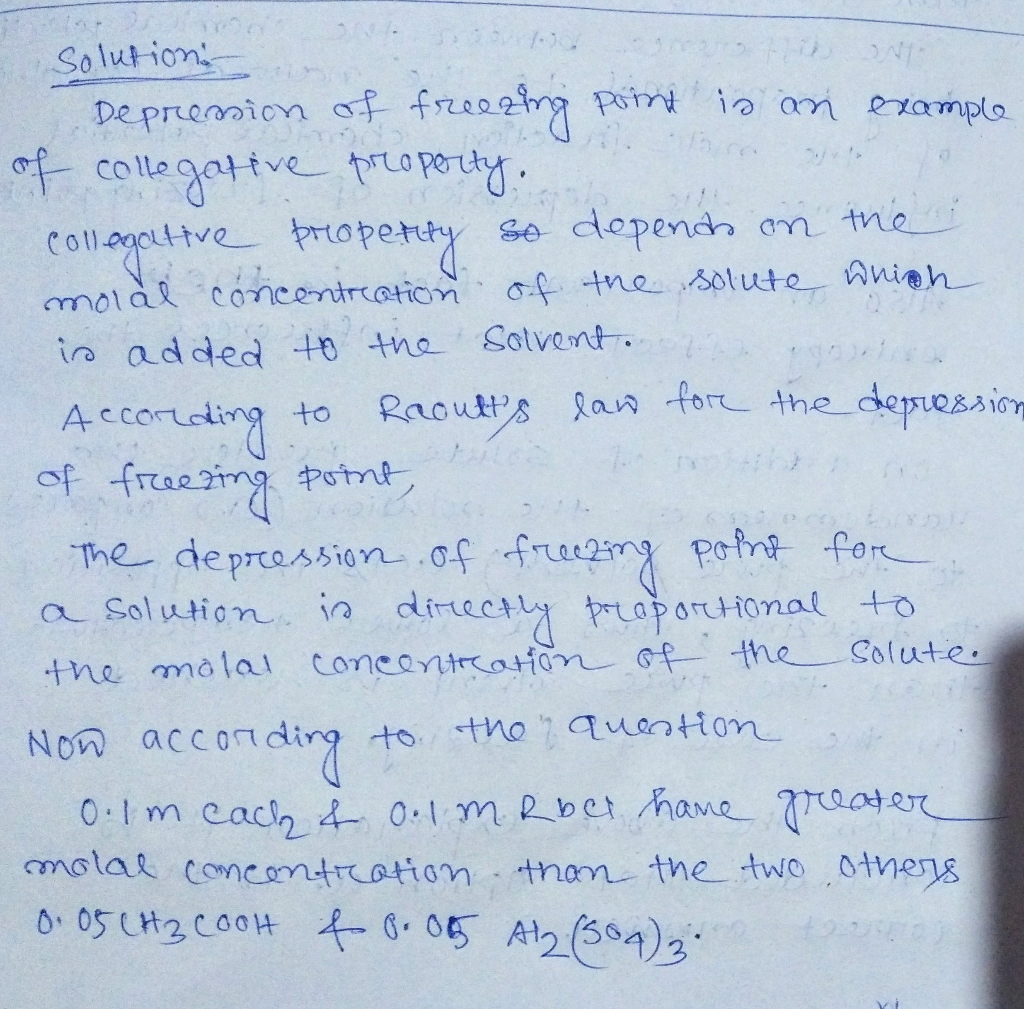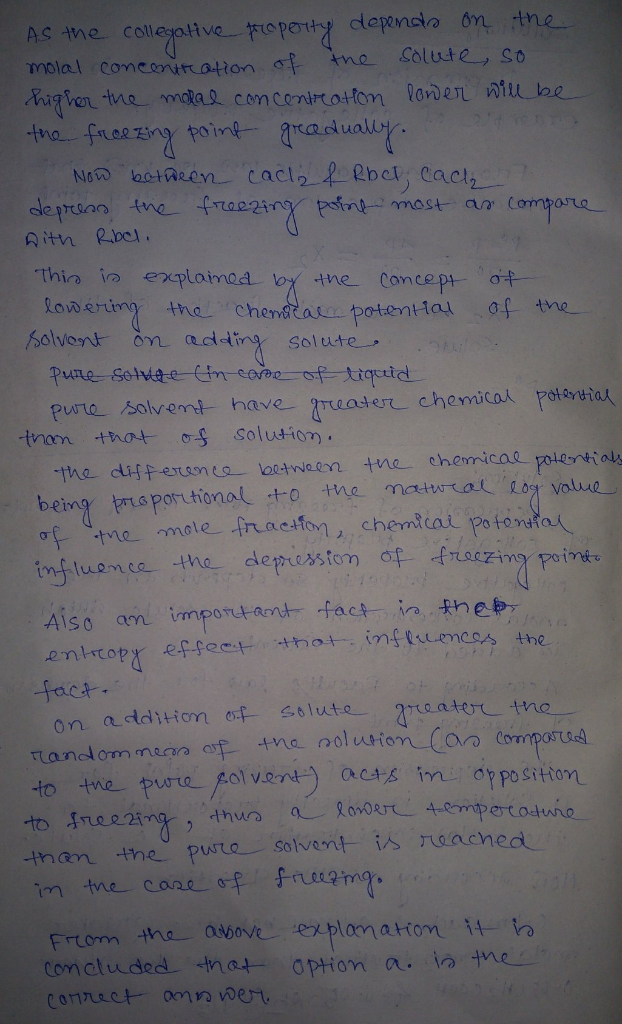Question
In: Chemistry
Assuming ideal behavior, which of the following aqueous solutions would be expected to exhibit the largest...
Assuming ideal behavior, which of the following aqueous solutions would be expected to exhibit the largest freezing-point lowering?
a. 0.1 m CaCl2
b. 0.05 m CH3COOH
c. 0.05 m Al2(SO4)3
d.0.1 m RbCl
The answer key I have says the answer is A, is that correct?
Solutions
Related Solutions
a. Which of the following elements would be expected to have the largest position in the Periodic Table?
a. Which of the following elements would be expected to have the
largest position in the Periodic Table? o Bromine o Cobalt o
Gallium o Rubidium o Scandiumb. Given the following electron Configuration 4d, what element
has this as the distinguishing electron? o Kryton o Arsenic o
Palladium o Nickel o Ironc. How many electrons does the valence shell of the mercury atom
contain? o 2 o 5 o 6 o 8
Assuming ideal behavior, which of these gas samples has the greatest volume at STP? 1 g...
Assuming ideal behavior, which of these gas samples has the
greatest volume at STP?
1 g of Cl2
1 g of Ar
1 g of Ne
Arrange the following gases in order of decreasing density at
STP:
Rank from largest to smallest.
F2
HBr
O2
He
Assuming complete disassociation of electrolytes which of these aqueous solutions has the LOWEST freezing point (reminder...
Assuming complete disassociation of electrolytes which of these
aqueous solutions has the LOWEST freezing point (reminder 1 molal=1
mol kg-1) 0.15 molal KCl 0.20 molal methanol 0.40 molal methanol
0.10 molal K2O 0.10 molal KCln
Which of the following aqueous solutions are good buffer systems?
Which of the following aqueous solutions are good buffer systems? 0.33 M nitrous acid + 0.27 M potassium nitrite 0.24 M nitric acid + 0.23 M sodium nitrate 0.32 M ammonium nitrate + 0.33 M ammonia 0.16 M hypochlorous acid + 0.12 M sodium hypochlorite 0.16 M potassium fluoride + 0.28 M hydrofluoric acid
Which of the following aqueous solutions are good buffer systems?
Which of the following aqueous solutions are good buffer systems? 0.35 M barium bromide + 0.21 M sodium bromide 0.21 M hydrobromic acid + 0.21 M sodium bromide 0.20 M calcium hydroxide + 0.27 M calcium chloride 0.18 M hydrocyanic acid + 0.22 M potassium cyanide 0.29 M ammonia + 0.36 M barium hydroxide
Which of the following aqueous solutions are good buffer systems?
Which of the following aqueous solutions are good buffer systems? 0.21 M perchloric acid + 0.22 M potassium perchlorate 0.14 M potassium hypochlorite + 0.20 M hypochlorous acid 0.38 M acetic acid + 0.30 M potassium acetate 0.28 M ammonium bromide+ 0.36 M ammonia 0.11 M hydrofluoric acid + 0.13 M potassium fluoride
Which of the following aqueous solutions are good buffer systems?
Which of the following aqueous solutions are good buffer systems? 0.16 M acetic acid + 0.21 M potassium acetate 0.26 M perchloric acid + 0.19 M sodium perchlorate 0.19 M potassium cyanide + 0.25 M hydrocyanic acid 0.37 M hypochlorous acid + 0.24 M sodium hypochlorite 0.35 M ammonium bromide + 0.34 M ammoniaWhich of the following aqueous solutions are good buffer systems? 0.12 M acetic acid + 0.15 M potassium acetate 0.34 M ammonia +0.35 M ammonium bromide 0.10 M barium hydroxide + 0.24 M barium chloride 0.35...
Which of the following aqueous solutions are good buffer systems?
Which of the following aqueous solutions are good buffer systems? 0.31 M ammonium bromide +0.37 M ammonia 0.18 M potassium fluoride + 0.23 M hydrofluoric acid 0.34 M hydrocyanic acid + 0.23 M sodium cyanide 0.24 M hydrochloric acid + 0.21 M sodium chloride 0.22 M acetic acid + 0.18 M sodium acetate Which of the following aqueous solutions are good buffer systems? 0.33 M calcium nitrate + 0.25 M sodium nitrate 0.14 M calcium hydroxide + 0.22 M calcium chloride 0.30 M ammonia + 0.38 M potassium hydroxide 0.14...
Which of the following aqueous solutions are good buffer systems?
Which of the following aqueous solutions are good buffer systems? 0.23 M nitric acid + 0.18 M sodium nitrate 0.13 M calcium hydroxide + 0.24 M calcium chloride 0.19 M hydrofluoric acid + 0.11 M sodium fluoride 0.35 M hypochlorous acid + 0.28 M potassium hypochlorite 0.34 M ammonium nitrate + 0.36 M ammonia
Which of the following solutions would be expected to have the highest total molarity of all...
Which of the following solutions would be expected to have the
highest total molarity of all ions
A. 0.5M CrCl3
B. 0.5M NH4NO3
C. 0.5M BaBr2
D. 0.5M NaC2H3O2 E. 0.5M Li2CO3
ADVERTISEMENT
ADVERTISEMENT
Latest Questions
- Coors and Anheuser-Busch (Budweiser) are competing against each other to try to capture a larger share...
- a) How much heat is required to change a 31.3 g ice cube from ice at...
- Two hockey pucks are moving to the right with puck 1 behind puck 2. Puck 1...
- Imagine that you are in the following real life situation. You are working in the human...
- In the AD-SRAS-LRAS model, what happens to the price level and the unemployment level in the...
- Suggest a policy aimed at encouraging female workforce participation and briefly explain how it might achieve...
- Assume the branch manager is not satisfied with the widths of the obtained confidence intervals, and...
ADVERTISEMENT


 queen_honey_blossom answered 1 month ago
queen_honey_blossom answered 1 month ago